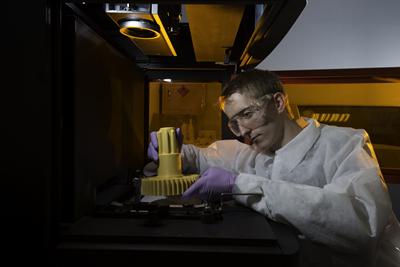Two rapid prototyping facilities, worth £300K, have been installed within the Engineering and Design Manufacturing Centre. These machines are designed to quickly produce a model of a physical part using three-dimensional computer aided design data. They provide greater design freedom, fast design process, more efficient materials usage and tool-less manufacturing.

The new facility includes access to expert design staff who are fully trained in using two state-of-the-art prototyping machines;
A powder based 3D Systems Z Printer Z650 machine: This prints the 3D part’s cross sectional geometry on layers of powder spread on top of each other. Layer by layer these sections are bonded together until the process is complete.

A plastic photopolymer-based ZBuilder Ultra machine: This prints the 3D parts in a material that is more robust than powder.
The newly refurbished lab which holds these machines also includes two BFB3000 rapid prototyping colour printers.
Our rapid prototyping machines are a significant investment in teaching, research and enterprise within Engineering and the Environment.
Investment in teaching
As part of the Undergraduate curriculum students are introduced to the exciting new 3D printing technology during Year 1 and as a result they are better equipped for employability in a changing world. Furthermore, the facility is flexible and personalised, therefore students will be able to use their theoretical and practical knowledge to create designs, have them printed off within a few hours and walk out of the lab physically holding what they have designed.
Advantages of this revolutionary technology
- Material wastage is minimised
- Production lead times are decreased to a fraction of their conventional equivalent.
- Costs are drmatically reduced.
- 3D printed products can be compared with other parts for compatibility and performance tests can be conducted.
- Errors can be caught earlier and therefore money can be saved before the product goes into production.
Links to industry and enterprise
The rapid prototyping techniques have been embraced by research and enterprise and have already produced a number of world firsts including the first 3D printed plane. In previous years particular types of aircraft wing, such as the elliptical wing that contributed to the success of the Supermarine Spitfire, have been too complex and expensive to build using modern manufacturing techniques. But with the introduction of 3D printing, these designs have been revisited.
Contact:
Kevin Smith
kevin.smith@soton.ac.uk